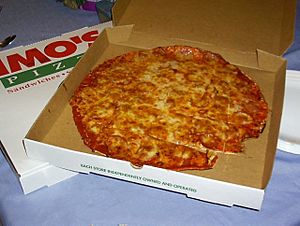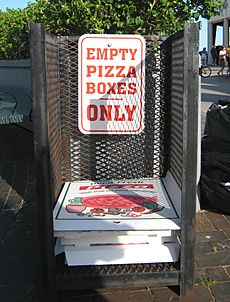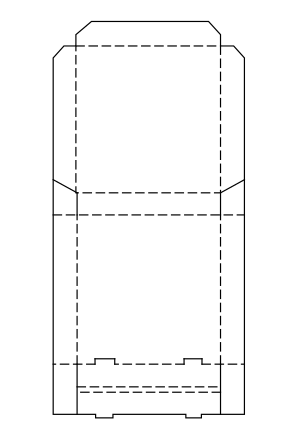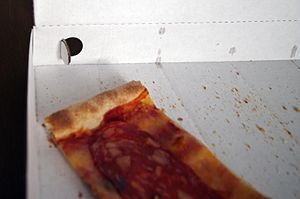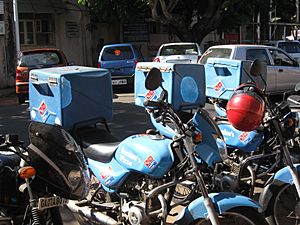Pizza box facts for kids
A pizza box is a special folding box made of cardboard. It's used to hold hot pizzas when you pick them up or have them delivered to your home. These boxes make it much easier to carry pizzas. A good pizza box needs to be strong, cheap, and easy to stack. It also needs to keep the pizza warm and prevent it from getting soggy. Plus, there's often space on the box for advertising! Pizza boxes are different from the packaging for frozen pizzas, which usually come in plastic wraps.
Contents
History of Pizza Boxes
People have been using containers to deliver fresh pizzas since at least the 1800s. In Naples, Italy, pizza makers used special metal containers called stufe (which means "ovens"). These were round and made of tin or copper, and they helped keep the pizzas warm as they were sent to street sellers.
Disposable packaging started to appear in the United States after World War II. Pizza was becoming super popular, and the first pizza delivery services began. At first, they tried using simple cardboard boxes, like those for cakes. But these often got wet, bent, or even broke! Other chefs tried putting pizzas on plates and carrying them in paper bags. This helped a bit, but it was hard to carry more than one pizza at a time without squishing the top ones.
The first patent for a pizza box made of corrugated cardboard was filed in 1963. This new design had all the features we see today: it started as a flat piece, could be folded without glue, was easy to stack, and had small holes for air. These air holes, along with materials that soaked up water vapor, stopped the pizza from getting soggy.
Many people believe that Domino's Pizza invented the modern pizza box, even though they didn't file a patent for it. Domino's was one of the first companies to use these boxes on a very large scale. This helped them deliver pizzas much further away from their restaurants. By the late 1960s, delivery services got even better with the invention of special heat-insulating bags.
In 2019, Pizza Hut announced they were trying out a new, high-tech round pizza box design.
What Makes a Good Pizza Box?
Strong and Stackable
Most pizza boxes are made from cardboard. Cardboard is great because it's cheap, easy to work with, and light. But it's also strong enough to hold and deliver pizzas safely. Both solid cardboard and corrugated cardboard (the kind with wavy layers inside) are used. The wavy cardboard often has very small waves (called E flute) or slightly thicker waves (B flute).
The strength of the box isn't just about the cardboard's thickness. It also depends on the type of paper used. Often, a special paper called containerboard is used on the inside of the box. This makes the box stronger and helps it resist moisture and oil from the pizza.
To save space, pizza boxes are stored flat and then folded into shape just before they are used. The amount of storage space needed depends on how thick the cardboard is. Boxes made from solid cardboard take up much less space than those made with wavy cardboard.
The way a box is folded also affects its strength. The most common design today has flaps that are firmly attached to the side walls and then folded into the front wall. This design connects the walls at the edges, making the box much more stable. The traditional way of folding a box is an example of this. One small downside is that the vertical walls can make it a bit tricky to cut the pizza inside the box with a pizza cutter.
Keeping Pizza Warm and Not Soggy
A pizza box has a tricky job: it needs to keep the pizza warm but also stop it from getting soggy.
First, the box needs to insulate the pizza from the cold air and wind outside. To do this, the box should close as tightly as possible to trap the warm air inside. Most people like their pizza to be between 70 and 85°C (158 and 185°F) when they eat it.
Second, the box must prevent the pizza from becoming soggy. When a hot pizza is put into a closed box, it creates steam. This steam can make the crust and toppings soft. To stop this, pizza boxes have small air holes. The cardboard itself also lets some moisture escape. If a box doesn't have extra insulation, the pizza can cool down too much in just ten minutes.
Sometimes, the oil from the pizza dough can affect the cardboard. To prevent the pizza's taste from changing and to stop the cardboard from getting soggy, some pizza boxes have a thin layer of aluminum foil inside. Another option is to place the pizza on aluminum foil, special absorbent paper, or waxed paper. However, these can change how the box keeps the pizza warm and how moisture escapes. For example, if the bottom of the pizza can't release moisture downwards, it might get soggy.
For Pizza Delivery
Pizza Saver
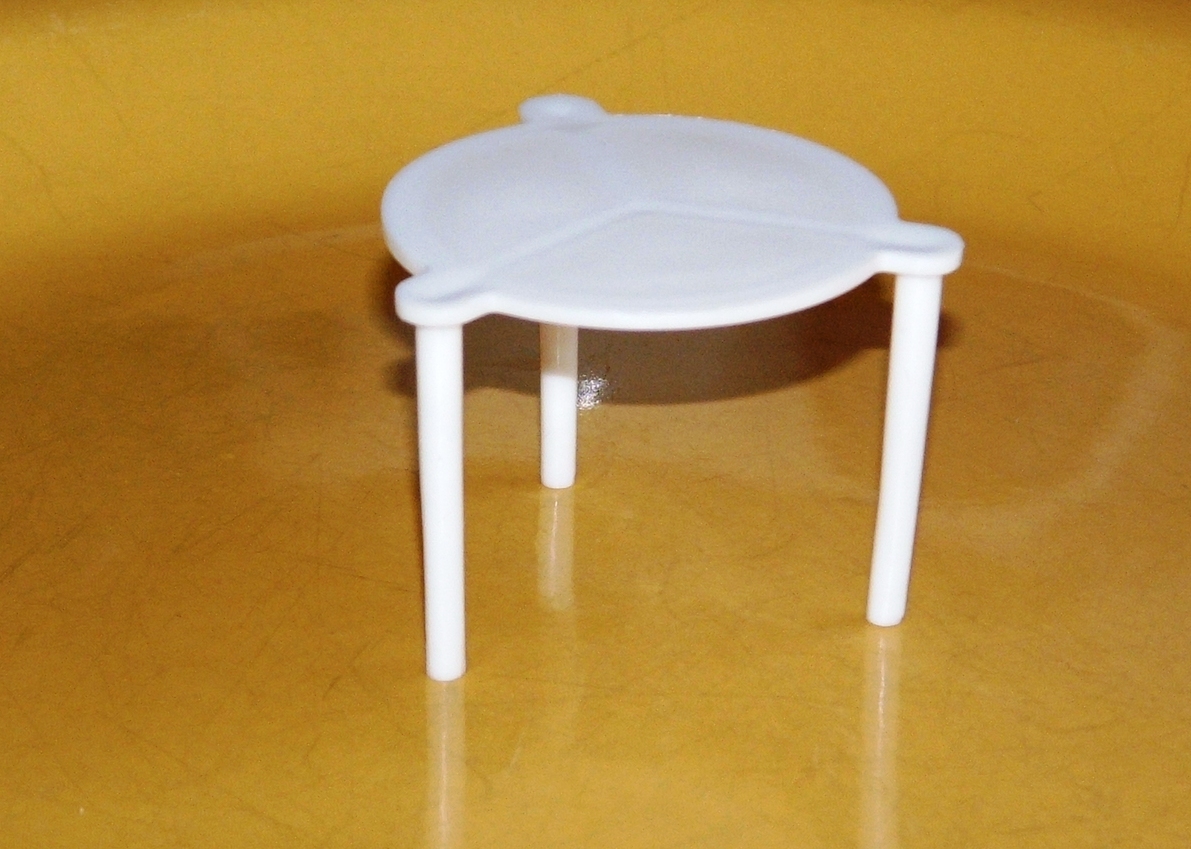

Bags and Boxes for Transport
Pizza delivery services often use special padded bags and boxes to carry pizzas. Some of these bags can even be heated! They can plug into a wall socket or a car's 12-volt battery to keep the pizzas warm. This means the insulation of the pizza box itself becomes less important. These bags usually insulate best when their lid zips up on three sides. A typical bag can hold about three to five pizza boxes.
Pizza Box with Thermometer
Some Pizza Hut pizza boxes in places like Morocco have a special thermometer indicator on the outside. This indicator changes color to show how warm the pizza is inside. When the pizza is hot, it shows "HOT" in red letters. But if the pizza cools down too much, the indicator turns black, and the words are no longer visible.
Reusing and Recycling Pizza Boxes
One new idea is a reusable pizza box. These are made from recyclable plastic and can be round or square. They have different lid options, often with vents. You can wash them by hand, in a dishwasher, or have them cleaned professionally to use them again and again. A big plus for reusable boxes is that the pizza doesn't absorb any taste from the cardboard.
Another option is biodegradable or compostable boxes. These are often made from materials like sugarcane, bamboo, or other plant-based materials. Like cardboard boxes, there are many different designs available.
Most new types of pizza boxes can be carried, stacked, and nested (fit inside each other) just like traditional cardboard boxes, whether they are empty or full. They also work well with transport bags or warming bins. While cardboard boxes are usually delivered flat and need two storage areas (one for flat boxes, one for folded ones), many of the new reusable options only need one storage area.


